Cycle One: Immersive Theatre
Posted: April 3, 2025 Filed under: Uncategorized | Tags: adobe, cycle 1, immersive theatre, Isadora, premiere pro, theater, theatre Leave a comment »For cycle one, I wanted to take the tools I had been equipped with over the first half of the course and utilize them in a theatrical context.Knowing that I would only be working with a bite sized chunk of work, I decided to revisit a play I had developed in a composition class my first year. It was a 20-ish minute play called The Forgotten World of Juliette Warner. It is a piece that juxtaposes the heroine’s journey with the stages of Alzheimer’s diseases. A theatrical convention of this piece in its initial construction was an ever changing set, meant to reflect the mind of the titular character where nothing is truly settled. Having actor’s move literal mats and blocks constantly was a barrier when establishing the suspension of disbelief. So recently trained in projection mapping, I developed a score around mapping the environments and bringing the audience inside the world.
My original score:
Resources Needed:
- Software: Isadora
- Hardware: Projector, long HDMI cables
- Space & Physical Elements: MOLA access, boxes, rolling boards, or curtains
Steps to Achieve This:
- Organize blocks, rolling boards, or curtains in the MOLA space as the base setup.
- Map the projector to these surfaces.
- Design and program projections to depict the shifting realities of Juliette’s world.
- Create a control board in Isadora for ease of access.
- Source actors.
- Rehearse.
- Present.
In my original score, I had anticipated projecting onto flat surfaces and possibly a curtain. But after our Motion Lab Demonstration, I observed a track for curtains that ran circular which I was immediately drawn to. So the first two days, with the gracious help of my peer Michael, I worked to understand routing NDI sources to 3 projectors in the motion capture lab. Through trial and error, we overcame a major barrier on day 2. When sending an NDI signal over a closed internet connection, many computers such as mine, will not send the signal if a firewall is enabled. After disabling the firewall, I was off to the races.
In IsaDora, I utilized EJ McCarthy’s focus grid to understand how to canvas the curtains properly. This was a meticulous effort that took nearly a whole class. I find that I can often get so focused on the specifics of the work, that I forget to take a step back and look at the big picture. So towards the end of class, I threw up some stock footage on all 3 curtains and to my surprise, I found that nearly everything is more forgiving than the focus grid.

With my surfaces properly mapped for projection, it was time to turn to the script. This piece has always been one that makes me nervous because I want to handle this difficult subject matter with as much care as possible. So to avoid alienating my peers/the audience, I selected a brief snippet that occurs earlier in the play that revolves around a repeated daily occurrence, grabbing coffee. I felt that both the environment and the interaction would be familiar enough to put audiences at ease while also providing a great opportunity to show the evolution of Juliette’s mind. When writing this scene, I found that this scene occurred at these stages of the heroine’s Journey/Alzheimer’s development:
STAGE 3 – Noticeable Memory Difficulties (3A.The Awakening)
STAGE 4 – More Than Memory Loss (3B.Preparing for The Journey)
With one day left in class to work on this project, it was time to generate. Although I did not have this software initially in my score, I decided that Adobe Premiere Pro would be the best canvas to create this scene. I sourced stock footage and audio from both Adobe and Pixabay (an EXCELLENT source if you haven’t checked it out).
I had to source footage that could suggest a coffee shop without needing to be in full focus, I didn’t want the projections to be a focal point for the audience. I eventually settled on a nice loopable clip and to make the transition gradual, I then started the scene with a circular gaussian blur at the center and over the course of the 2 and half minute scene allowed it to encompass the entire video. I then created a sound design based on stock noises. With the audience being on the inside of the curtains, I felt it was important to not only surround them visually, but sonically. I utilized surrounding reverbs and panning to allow sounds to come from specific points in the room.
I moved this scene into my ISADORA file where it replaced the focus grid and easily projected on all 3 surfaces.
On the cue line “my mind” I set up a second scene in Isadora which would be the Doctor’s office. I used a similar approach to the coffeeshop, but reversed the blur effect. I did this to intentionally throw off the audience, to tell them that we were somewhere different, somewhere with much more sterile light, but slowly allowed that to be revealed over time.
With my projections designed, it was time to implement actors. I did source a few actors who agreed to take part in a staged reading of the scene. Given the nature of a class project, all my actor’s eventually backed out which led me to scramble for new actors. When I presented the piece in class, I was only able to give my actor’s their given circumstances and the instruction to follow their impulses. This created a sense of a scene, but led to some confusion in character dynamics and audience attention. For my personal taste, it created some clunky staging, but I was so thankful to have 2 actors who were gracious enough to jump in and with a brief rehearsal, we could have ironed this out.
In the feedback, which was extremely valuable, I learned that there was room to go further with the visual design. While the current projections and sound designs were immersive according to my peers, the same visual on all 3 surfaces created an uncanny blend that actually kind of takes the audience out of it. That being said, I did receive feedback that my approach was tasteful and the blur effect, while discrete, was noticed. Perhaps my biggest takeaway from the feedback was that there is a real opportunity to continually define and redefine the audience relationship. The coffee shop very much sent the message “I want you to be a part of this”, but the doctor’s office provides an opportunity to flip that on its head and push the audience out. When I continue to work with this project in cycle 3, I will explore how lighting can be a tool for achieving this effect. My question I will investigate is, “When can I afford to truly leave the audience in the dark”.
Overall, I am happy with the shape this project took. While it did not look at all how I originally intended, I was pleased to expand my muscles with NDI AND projection mapping at the same time while providing a unique theatrical experience for the audience. I laid the groundwork for a compelling piece and with an updated score and a bit more time, I can lean into the aspects of this project that were lost to time.
Cycle 1: It Takes Two Magic Mirror
Posted: April 1, 2025 Filed under: Uncategorized | Tags: cycle 1, Interactove Media, Isadora, magic mirror Leave a comment »My project is a magic mirror of sorts that allows for interaction via an XBox One Kinect depth sensor. The project is called “It Takes Two”, because it takes two people to activate. In its single-user state, the background and user’s shadow are desaturated with a desaturation actor linked to the “Bodies” output of the OpenNI Tracker BETA actor. When the sensor only detects 1 body (via an Inside Range actor), it puts the saturation value at 0. When a second body is detected, it sets the saturation value at 100. I have utilized envelope generators to ensure a smooth fade in and fade out of saturation.
The above patch was added onto the shadow mechanism I created. I did some research on how to achieve this, and experimented with a few different actors before concluding that I needed an Alpha Mask. The LumaKey actor was one I played with briefly but it did not do what I needed. I found a tutorial by Mark Coniglio, which is how I ended up in alpha-land, and it worked beautifully. I still had to tinker with the specific settings within the OpenNI Tracker (and there is still more to be fine-tuned), but I had a functional shadow.
My goal with Cycle 1 was to establish the base for the rest of my project so I could continue building off it. I sectioned off my time to take full advantage of lab time to get the majority of my work done. I stuck to this schedule well and ended Cycle 1 in a good position, ready to take on Cycle 2. I gave myself a lot of time for troubleshooting and fine-tuning, which allowed me to work at a steady, low-stress pace.
I did not anticipate having so much difficulty finding colorscape videos that would provide texture and contrast without being overwhelming or distracting. I spent about 45 minutes of my time looking for videos and found a few. I also ended up reusing some video from Pressure Project 2 that worked nicely as a placeholder and resulted in some creative insight from a peer during presentations. I will have to continue searching for videos, and I am also considering creating colored backdrops and experimenting with background noise. I spent about 20 minutes of my time searching for a sound effect to play during the saturation of the media. I wanted a sound to draw the users’ attention to the changes that are happening.
Overall, the reactions from my peers were joyful. They were very curious to discover how my project worked (there was admittedly not much to discover at this point as I only have the base mechanisms done). They seemed excited to see the next iteration and had some helpful ideas for me. One idea was to lean into the ocean video I borrowed from PP2, which they recognized, causing them to expect a certain interaction to occur. I could have different background themes that have corresponding effects, such as a ripple effect on the ocean background. This would be a fun idea to play with for Cycle 2 or 3.
The other suggestions matched closely to my plans for the next cycles. I did not present on a projector because my project is so small at the moment, but they suggested a bigger display would better the experience (I agree). My goal is to devise a setup that would fit my project. In doing so, I need to keep in mind the robustness of my sensor. I needed a very plain background, as it liked to read parts of a busy background as a body, and occasionally refused to see a body. Currently, I think the white cyc in the MOLA would be my best bet because it is plain and flat.
The other major suggestion was to add more things to interact with. This is also part of my plan and I have a few ideas that I want to implement. These ‘easter eggs’, we’ll call them, will also be attached to a sound (likely the same magical shimmer). Part of the feedback I received is that the sound was a nice addition to the experience. Adding a sonic element helped extend the experience beyond my computer screen and immerse the user into the experience.

This is a screen recording I took, and it does a great job demonstrating some of the above issues. I included the outputs of the OpenNI Tracker actor specifically to show the body counter (the lowest number output). I am the only person in the sensor, but it is reading something behind me as a body, so I adjusted the sensor to get rid of that so I could demonstrate the desaturation. Because it saw the object behind me as a body, Isadora responded as such and saturated the image. The video also shows how the video resaturates breifly before desaturating when I step out and step back in, which is a result of the envelope generator. (The sound was not recording properly, please see above for sound sample.)
My score was my best friend during this project. I had it open any time I was working on this project. I ended up adding to it regularly throughout the process. It became a place where I collected my research via saved links and tracked my progress with screenshots of my Isadora stage. It helped me know where I was at with my progress so I knew what to work on next time I picked it up and how to pace myself across this cycle by itself and all three cycles together. I even used to to store ideas I had for this or a future cycle. I will continue to build on this document in future cycles, as it was incredibly helpful it keeping my work organized.
Cycle 1: A Touch of Magic
Posted: March 31, 2025 Filed under: Uncategorized Leave a comment »For this project, my primary strategy was to try to reverse engineer a piece of media I experienced in a queue at Disney World. I was pretty sure I understood how it was working, but I was curious if I would be able to reconstruct some portion of it on my own. After thinking about the patterns, I knew the media sequence was a series of scenes that were just variations on one another with either some kind of count trigger or time marker that triggered the movement into the next scene. I also wanted to use this as an opportunity to explore a depth sensor, as a tactic to experiment with other interactive media I’ve seen used in various capacities. The two together were challenging, and I think there were ways that I could have created a more polished finished product if I had focused on one thing or another. I think this is a byproduct of me originally imagining a much bigger/flashier end product at the end of the three cycles, which I have since scaled back from significantly. In the end, these cycles will end up serving more as vehicles for me to continue to learn and explore so I can better recognize how these tools and technologies are working out in the wild, thereby making me a better partner to the people who are actually executing the media side of things.
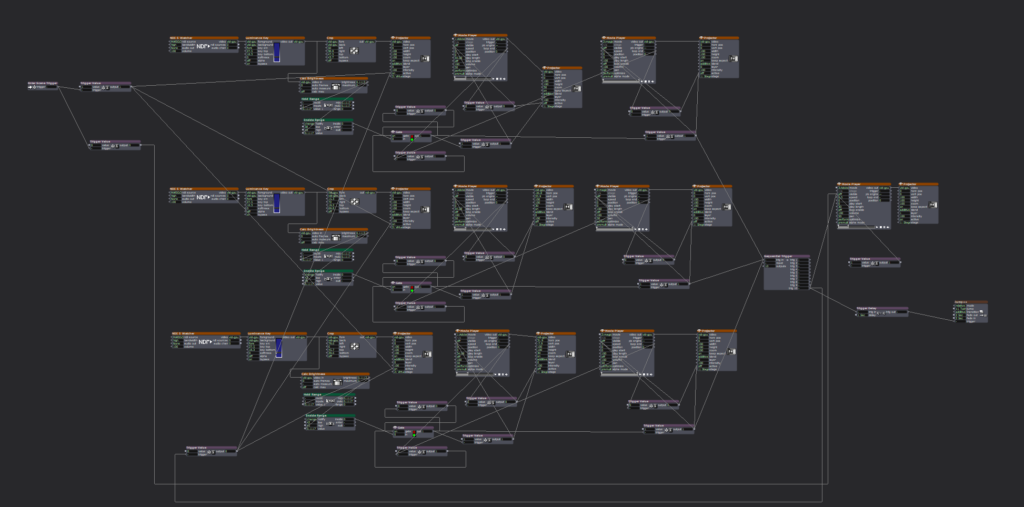
Figure 1: No Time for Making Things Neat
The tools I used for this were a depth sensor, Touch Designer mainly because Isadora couldn’t recognize the depth sensor without it, and Isadora. In Isadora, I used a Virtual Stage for the first time in one of my projects. It helped me be able to see where the areas were I was isolating with the depth sensor, while keeping it separate from the area where the interactive pieces were being triggered. I used the Luminance Key, NDI Watcher, and Calc Brightness actors for the first time in a project and continued to enjoy the possibilities of triggers, gates, and sequential triggers. I find that I am always thinking about how the story progresses, what happens next, and in building in ways for what I’m creating to naturally bring up another scene or next thing once it’s reached a relatively low threshold or interactions or time.
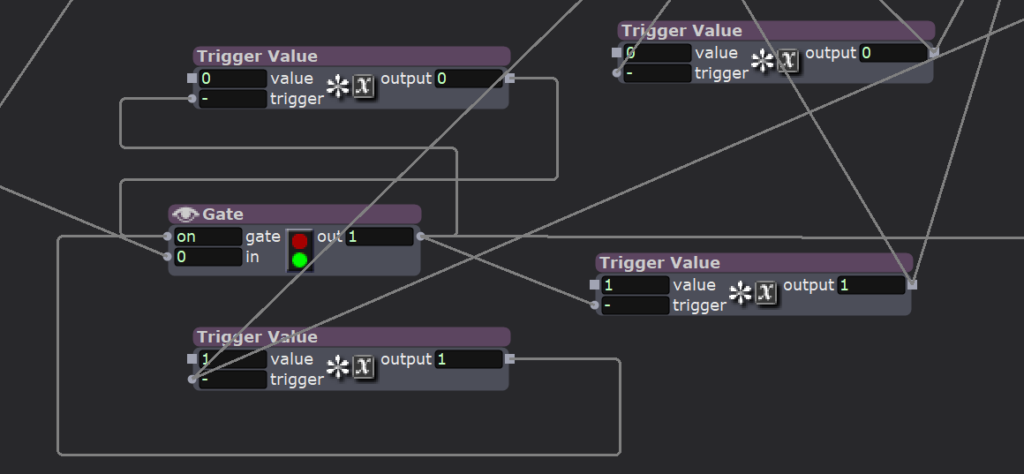
Figure 2: An Abundance of Gates and Triggers
Some challenges were that I didn’t quite author to the technology, which caused some issues, and I didn’t fully understand the obstacles I might encounter in moving from one space to another. The very controlled environment of a ride queue is perfect for these kinds of tools, and I feel like I understand much better, now, how this could work in a more controlled and defined space. I also think focusing on the challenges of a depth sensor alone and maybe using it to more carefully capture motion, rather than necessarily a range of depth, could have allowed this to be more sensitive and, therefore, successful. I certainly spent more time than I would have liked trying to figure out how to get the trigger to be less sensitive than I wanted it to be but sensitive enough to still fire, and I still didn’t quite figure it out.
I think the decision to trigger both a visual and auditory reaction when the specific areas were interacted with was a good one. The sound, especially, seemed like a success with my classmates interacted with it, and the simplistic nature of a little bit of magic on a black screen also worked well. It was noted that the specific visual and sound combination did make those playing with it want to do more magical motions or incited joy, so I think that those were good choices.
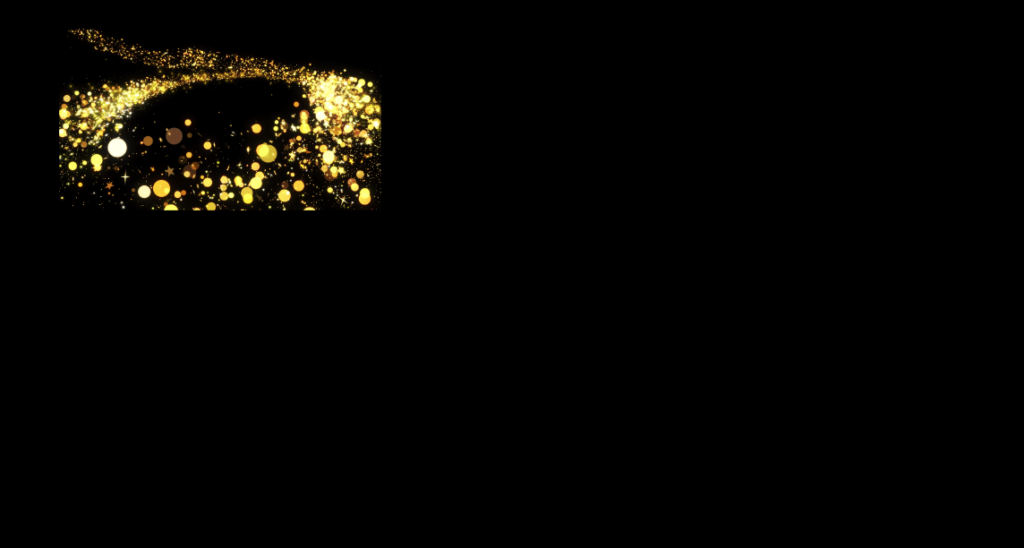
Figure 3: A Touch of Magic
I can’t help wishing the presentation would have been visually more polished, but I don’t really have the skills to make more finalized video product. Adobe stock leaves something to be desired, but it’s what I’m mostly working with right now, as well as whatever sounds I can find in a relatively short amount of time that kind of “do the job.” I think this is where my scenic design abilities need the other, media design part to fully execute the ideas that are in my head. As I said, though, I am primarily using these cycles to continue to explore and learn how things work.
In the end, I think the project elicited the responses I was hoping for, which mostly was for people to realize a motion in a specific space would trigger magic. I could also see how some magic incited the desire to seek out more, and I think that a more comprehensive version of this could absolutely be extrapolated out into the queue entertainment I saw at Disney.* I do think this project was successful, in that I learned what I set out to learn and it incited play, and, depending on how the coming cycles develop and what I learn, there feels like the possibility some of this might show up again in the coming cycles.
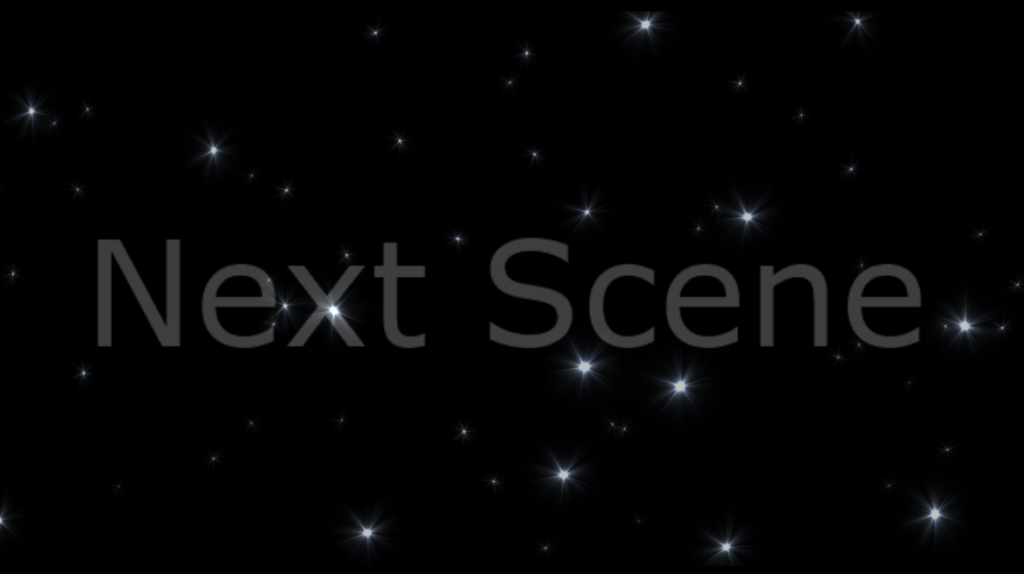
Figure 4: The To Be Continued Scene Transition
*In the queue, guests interacted with shadows of either butterflies, bells, or Tinkerbell. After a certain amount of time or a certain number of interactions, the scene would kind of “explode” into either a flurry of butterflies, the bells ringing madly, or Tinkerbell fluttering all around, and move into the next scene. Guests’ shadows would be visible in some scenes and instances and not in others, sometimes a hat would appear on a shadow’s head. I think I mostly figured out what was going on in the queue sequence, and for that, I’m very proud of myself.
Pressure Project 2
Posted: March 5, 2025 Filed under: Uncategorized Leave a comment »For pressure project two, I took my main inspiration from “A Brief Rant on the Future of Interaction Design” by Bret Victor. I was drawn to the call for tactile user interfaces and the lamentation of a lack of sensation when using our hands and fingers on touch screen “images below glass.” I wanted to create something that not only avoided the traditional user interface, but also avoided the use of screens all together. For this reason, I choose to focus on sound as the main medium and created the experience around the auditory sensation.
Having seen the Makey Makey’s around the Motion Lab for over a year, I was excited to finally use one and see what all the fuss was about. I was immediately inspired by the many options that became available to be used as a means of interacting with the computer. Anything that had even the slightest ability to exchange electrical charges could be used to trigger events on the computer.
Knowing that I wanted to focus on sound, I started off this exploration by recreating the popular Makey Makey example of the banana keyboard. Since I didn’t want to ruin multiple bananas for an experiment, I decided to use grapes instead. I was able to map the grapes to the tone generator actor in isadora and then it was just a matter for figuring out the frequencies of each note, which it turns out is quite specific and requires hard coding each note as a separate actor.
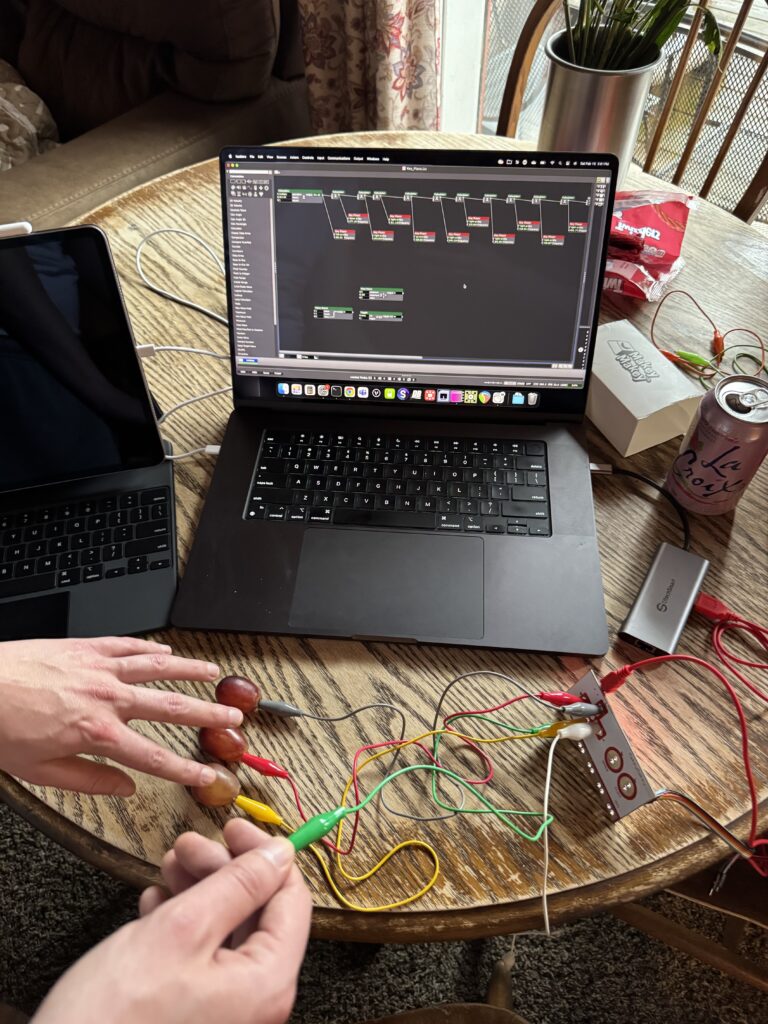
Since I considered this a simple proof of concept, I didn’t bother to create the whole keyboard and was satisfied with being able to play “hot cross buns” using the three notes I had programmed. When I finally had the patch working well, I quickly realized that the tone generator in Isadora was very one dimensional. It produced a pleasant sine wave but the result was something that sounded very robotic and computational. This was one component that I knew would need further refinement. While enjoyed the grapes as an instrument (and a snack) I knew I wanted something a bit more meaningful. I had considered using brail to spell out the notes, but I ended up deciding I would like to deviate further from the “keyboard” example and instead trigger sounds in a more abstract way.
Having successfully complete the basic outline of a patch, I took a few days to think about the different ways I could modify and expand the concept so that it no longer resembled a piano. I was encouraged to explore the “AU” actors in Isadora to expand the functionality of the audio handling in Isadora. I found these actors to be useful, but also a bit mysterious since I could not find any help documentation readily accessible. Through a process of trial and error, I found the actors that worked for my purposes and was able to have the control needed to complete the patch.
For the tactile inputs I was reminded of some basic 3 dimensional shapes that have been laying around in the Motion Lab. I don’t know their exact origin, but I liked the simple sphere, cube, cone and cylinder’s size and overall appearance, so I decided to use them as the human facing element of the project. The shapes simple form reminded me of some ancient truths as if they were the basic elements of the universe. When these basic building blocks are combined, the mystery will be revealed. At last, I found a way to fulfill the overarching requirement of pressure project 2.
Since I choose to make this a sound centric project, deciding on the sound effects that would be played was one of the most important aspects. I wanted something booth soothing and mysterious and was reminded of the souvenir “Tibetan singing bowls” that I had seen in the Christmas Markets of Europe. When the rim of the bowl is rubbed with a stick, the bowl starts to resonate like a bell and reverberates loudly in a very calming tone.
I downloaded some pre-recorded singing bowls from freesounds.org and after a bit of research, decided to cover the “singing shapes” in gold foil so that they resembled the metal bowls, but also so they would conduct electricity for the Makey Makey. Wiring everything up was a breeze and the basic patch I had made before only needed a few tweaks. The most difficult part was revealing the final “mystery” when all four shapes were activated at the same time, a 5th sound of a choir singing was activated.
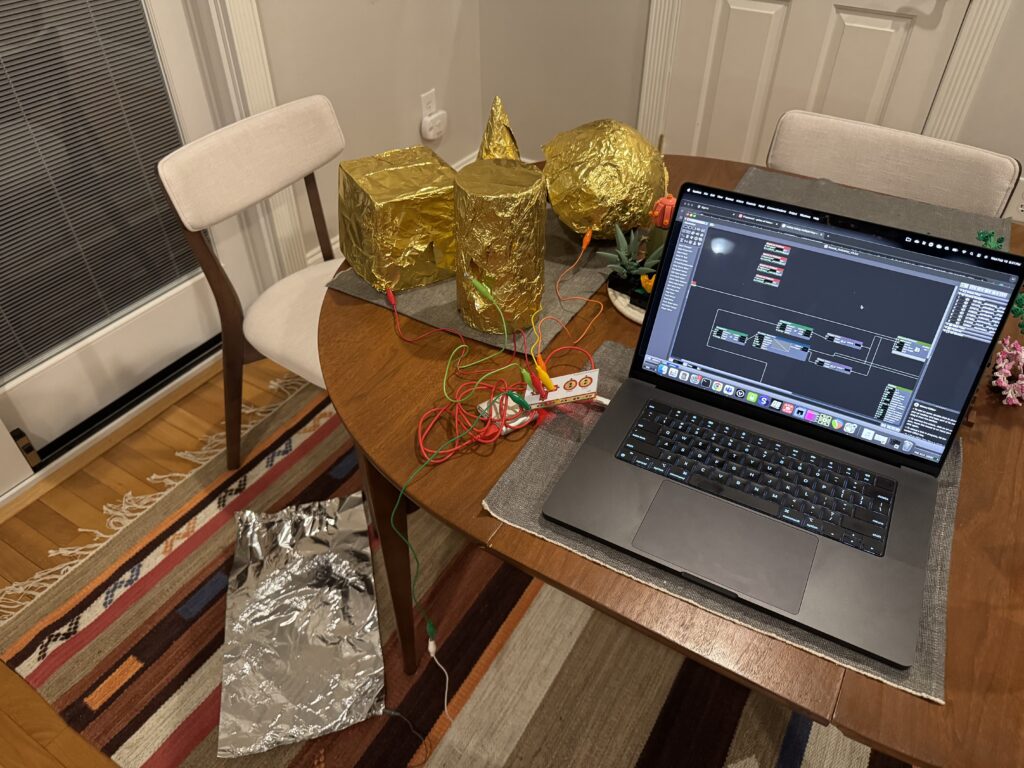
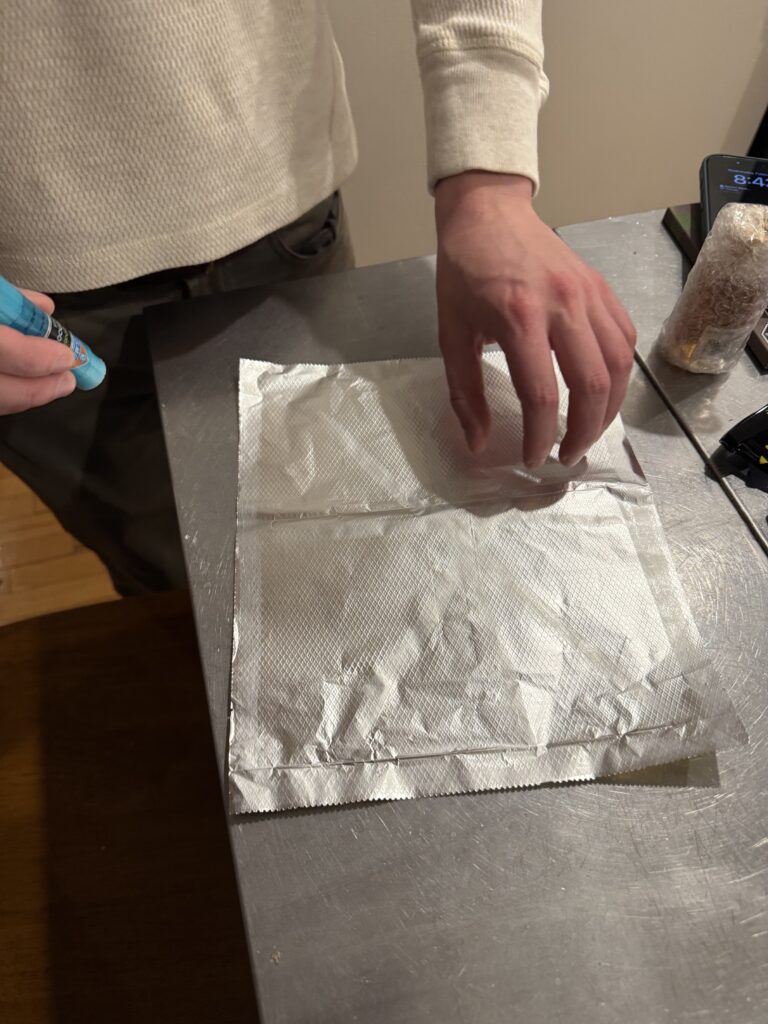
Finally, for the actual project presentation, I found myself with an extra hour to spare and an empty Motion Lab, so I decided to take the project to the next level and present a polished version to the class. I had this larger vision ahead of time, but was not planning on implementing it since I didn’t think I would have the opportunity, but I’m glad I did. A few mirrors that I found in the same box as the shapes, and an fortuitously focused lighting special added the finishing touch.
I was happy to watch the class interact with the singing shapes and it quickly became clear they were putting a lot more thought into the “mystery” than I did. There were a few theories about which shape did what function and if what order you pressed them in mattered, in reality they played the exact same sound every time and the order made no difference. Eventually they all were activated the same time and the choir began to sing. I don’t think it was obvious enough, because it was noticed, but there was no “ah ha” moment and I think people were expecting a bit more of a pay off. Either way, I had fun making it, and I think others had fun experiencing it, so overall I think it turned out well.
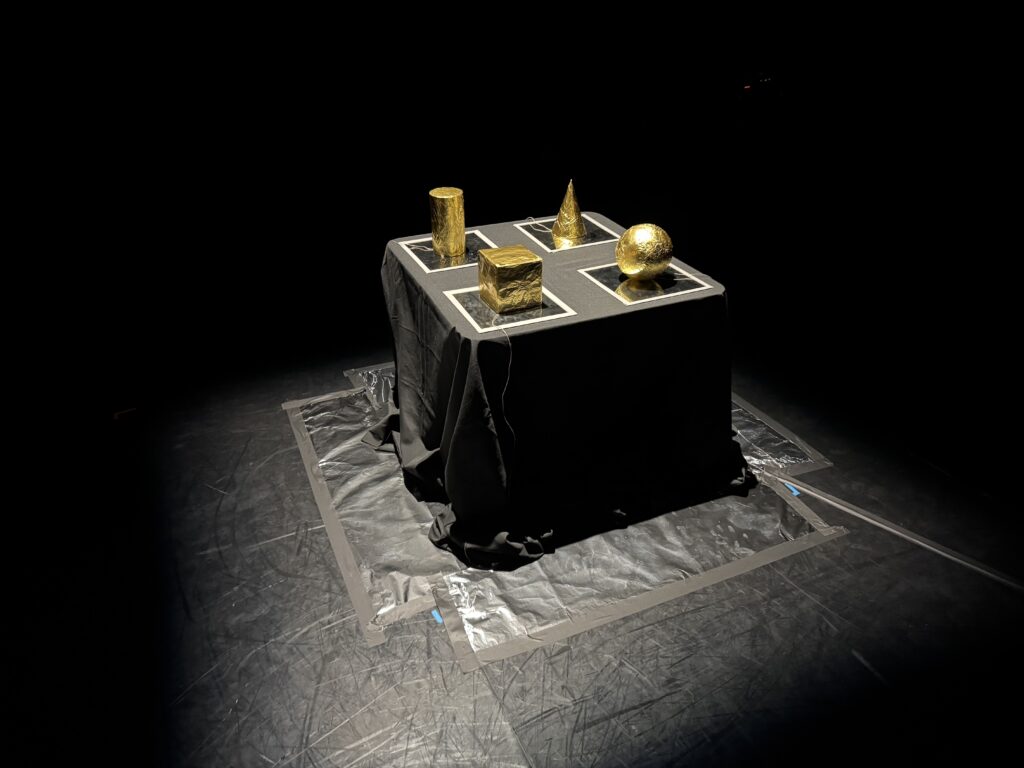
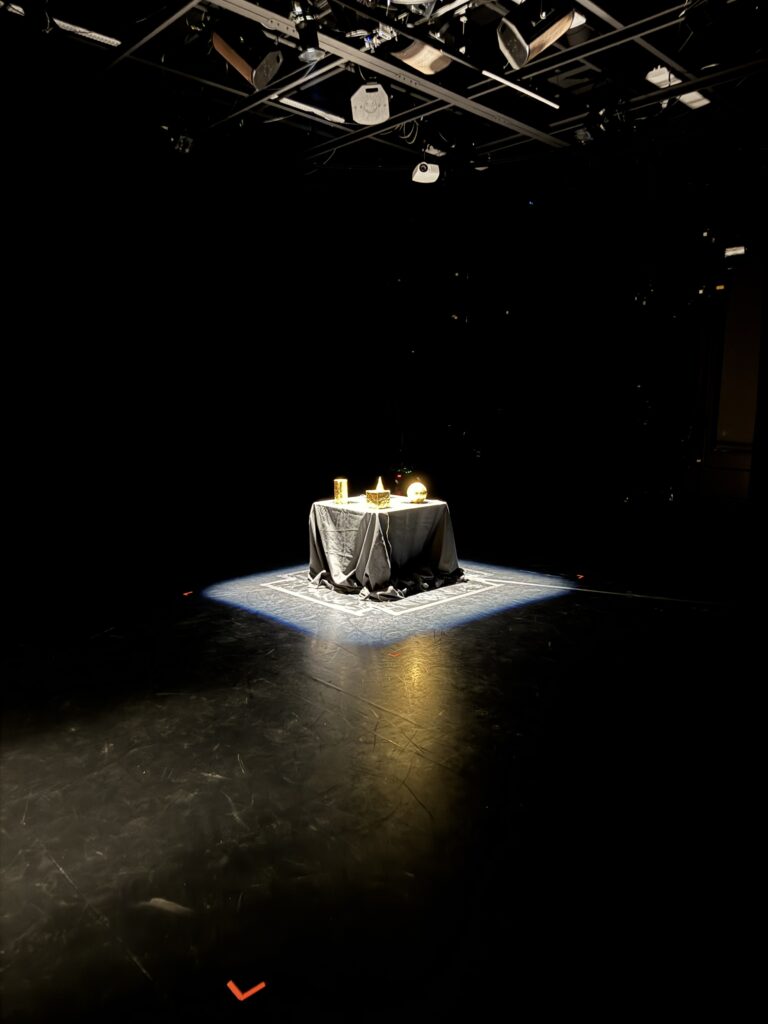
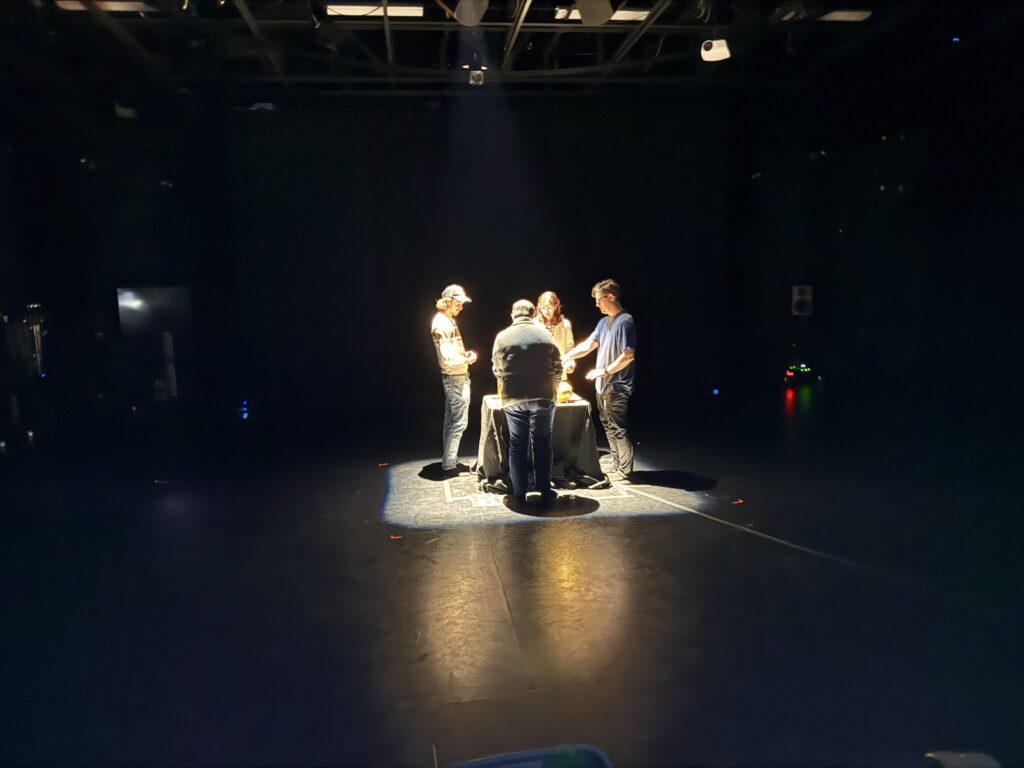
Pressure Project 2: Unveil the Mystery
Posted: March 3, 2025 Filed under: Uncategorized Leave a comment »For this pressure project, we had to unveil a mystery. Going into it, I had a general idea of what I wanted to create, but I faced many struggles during execution. I spent a good portion of my 7 hours doing research into different actors I would need and how to use them. I think I got so focused on the technical aspects that I pushed the storytelling aspect to the side and didn’t flush the story out as much as I wanted. Overall, though, my project was successful and I learned a lot.
I wanted to hide little mini mysteries throughout my project, so I built three scenes for the user to explore before getting to the end. Each scene has a base set of actors that I build on to customize the scene. I created a little avatar to move around the stage with a Mouse Watcher actor and added a sound effect (unique to each scene) that played when the avatar hit the edge of the stage. The avatar also completed a different action in each scene when the user hit a button on the Makey Makey interface I made.
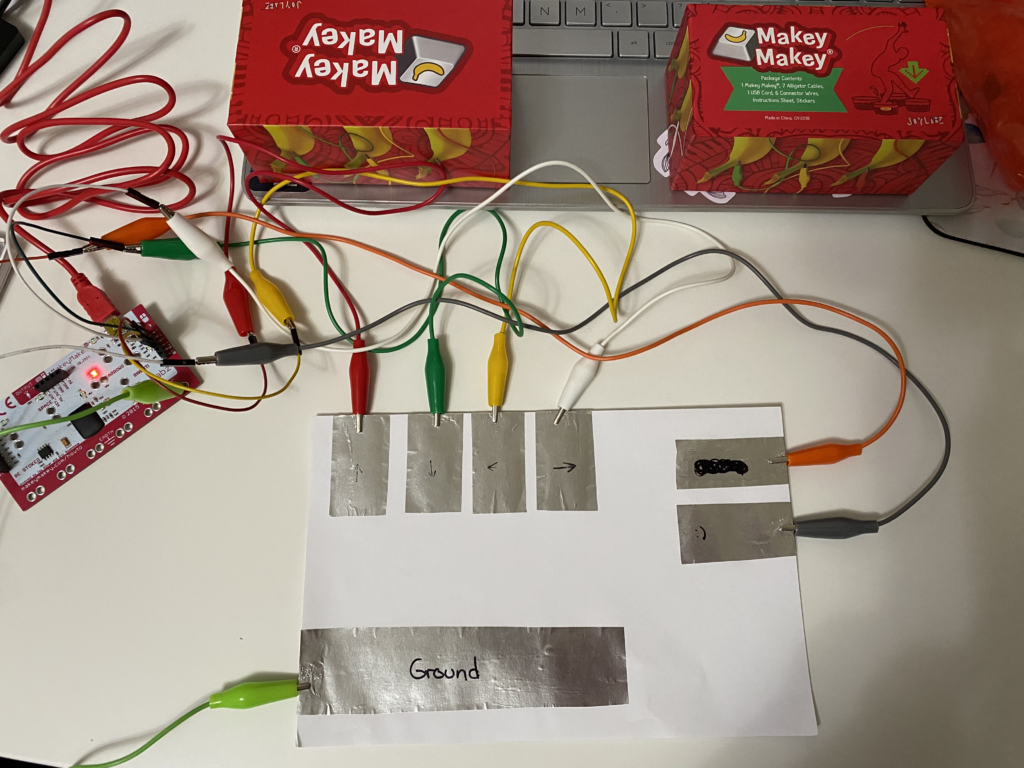
This is the Makey-Makey interface I made for myself, which allowed me to use it single-handed. I planned to make another one that was more like a video game controller but ran out of time.
In the intro scene, a digital city, the avatar jumped when the key was hit, and after 7 jumps, it inflated to take up a large portion of the scene, then quickly deflated. In the ocean scene, it triggered fish to “swim” across the scene so it could swim with the fish. In the space scene, the avatar teleported (an explosion actor was triggered to scatter the avatar’s pixels and reform them). Every scene had another key plugged into a counter actor, and after that key was pushed so many times, it jumped to the next scene. This project was designed to make the users curious to push all the buttons to figure out the mystery. A great suggestion I received was to put a question mark on the action button, which my peers agreed would be more effective than having it unlabeled.
I received a lot of positive feedback on my project, both verbally and through reactions. There were several moments where they were surprised by something that happened (aka a feature they unlocked), namely when the avatar first exploded in the space scene. I was surprised by this because I didn’t think it would be a big moment, but everyone enjoyed it. They went into it with an unlock-the-mystery mentality and were searching for things (oftentimes things that weren’t there), so they were happy to find the little features I put in for them to find before reaching the final mystery, which was that they won a vacation sweepstakes. They said the scenes felt immersive and alive because I used video for the backgrounds. Again, the space scene was a big hit because the stars were moving towards the user and was more noticeable than the more subtle movement of the ocean scene. There were multiple moments of laughter and surprise during the presentation so I am very pleased with my project.
The main critique was that the mystery was a bit confusing without context, and I do agree with that. One suggestion was to add a little something pointing to the idea of a context or raffle to add context for the final mystery, and another was to progress from the ocean to land to beach to get to the vacation resort or something along those lines. My original idea was to have portals between scenes and end with a peaceful beach vacation after traveling so far, but I ran out of time and didn’t dedicate enough time to telling the story that I ended up throwing something in at the end. They did say the final scene provided closure because the avatar had a smile (unique to this scene) and was jumping up and down in celebration.
I hit a creative rut during this project so the majority of it was improvised, contributing to the storytelling problem. I started by just making the avatar in the virtual stage because making a lil guy seemed manageable, and it sparked some ideas. I decided on a video game-esque project where the avatar would move around the scene. As I brainstormed ideas and started researching, I had a list of ideas for what could happen as the user navigated through my little world. I spent about 20-25 minutes on each idea on the list to figure out what worked. This involved research and (attempted) application. Some things didn’t work and I moved on to try other things.

I broke this project up into several short sessions to make it more manageable, especially with my creative struggles. This gave me time to sit and process/reflect what I had already done, attempted, and wanted to do. I was able to figure out a few mechanisms I had struggled with and go back later to make them work, which helped me move the project along. One time-based challenge I did not consider was how much time it would take to find images, videos, and sound effects. The idea to add these sonic and visual elements occurred much later in the process, so I did not have a lot of time left to adequately reallocate my time, so I do think I would have been better off creating a storyboard before diving right in to better prepare myself for the project as a whole.
Pressure Project #2
Posted: February 27, 2025 Filed under: Uncategorized Leave a comment »For Pressure Project 2, my strategy was to work on exploring some of the actors we’d been introduced to in class and think about applications. I also wanted to make something that I could see be extrapolated out into other uses, and I think that was successful. I chose to let the “mystery” be the mechanics (though I ended up making them more straightforward than originally planned), as well as how the thing itself was structured. I also wanted to focus on creating something that was smoother and ran in a more finished way by setting some attainable goals for myself, even though that is somewhat counter to the way we’re supposed to be thinking in this class, I think. I wanted the user facing side to look more finished than the programming that was holding it together (Figure 1, because everything is theatre). I tried not to spend as much time on story, this time, while still allowing for some kind of simple, cohesive structure to hold the project together. Moving forward, I’m trying to be more focused on creating interesting visuals with just enough story to hold them together, rather than being very story heavy at the expense of slightly more complex visuals (though I still think it worked well for Pressure Project 1).
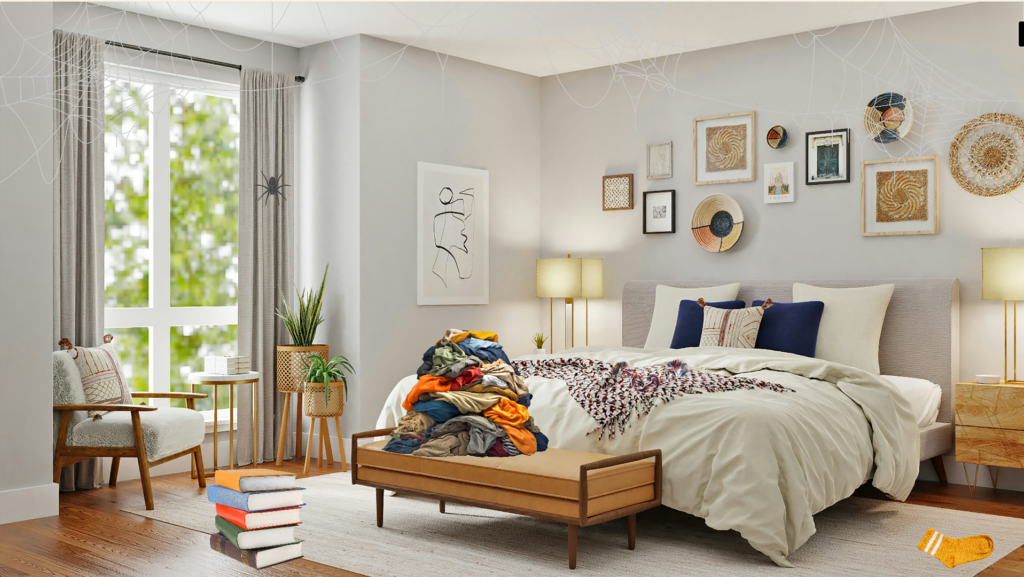
Figure 1: Tape, Glue, and Paint
I spent some time working with the Stage Mouse Watcher and a lot of time with triggers. I used them as both switches within the game, as well as, ultimately, a way to reset the scene, rather than manually turning all the projectors and effects on and off each time I wanted to test things. I wish I had thought of that much earlier in the process, but at least I have that under my belt for next time, now. I also explored Gates so that my sequential trigger wouldn’t keep firing and kick the project to the next scene prematurely. I felt especially good when I figured out how to implement that, as it made the unrolling of the game itself possible. At one point, the stars that replaced the items in the room triggered if you just moved the mouse over the correct spot. Late in the process, I decided to change it to clicking on the item. The mechanic felt like it make more sense, and I’m not sure why I didn’t think of it in the first place. I worked hard to keep my workspace neat and organized. Not that it really matters in the way the thing functions, but it helped me see the patterns and try to sus out when something wasn’t working correctly and then make the necessary changes across various actors. I realized after I built everything that there might have been a better way to use User Actors and simplify things/make the initial workspace neater, but ultimately, I didn’t really mind seeing everything laid out together. I think really cleaning up my workflow is a problem for later, when I’m faster at creating and fixing things. (Figure 2 and Figure 3)
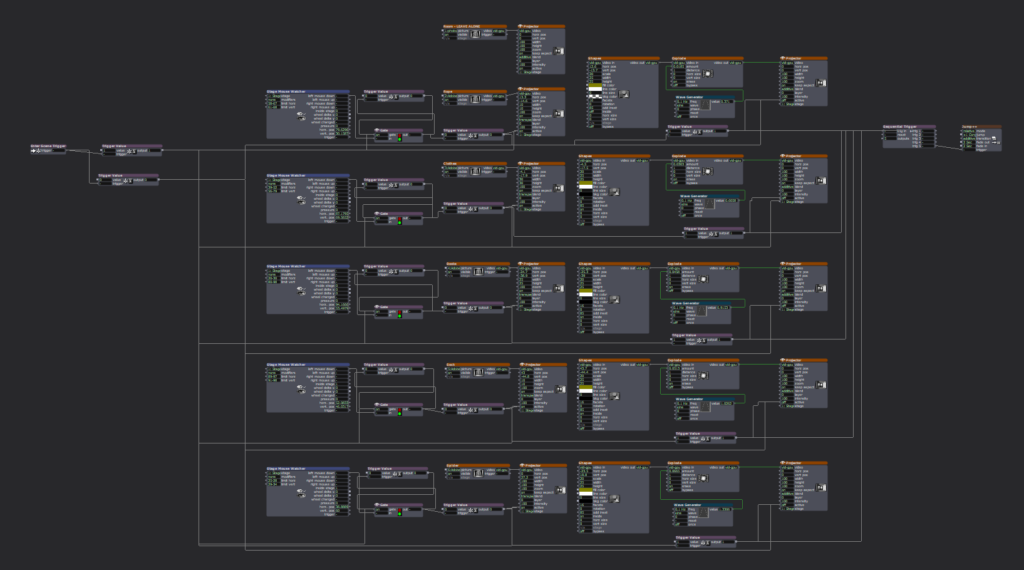
Figure 2: The Mess Behind the Scenes
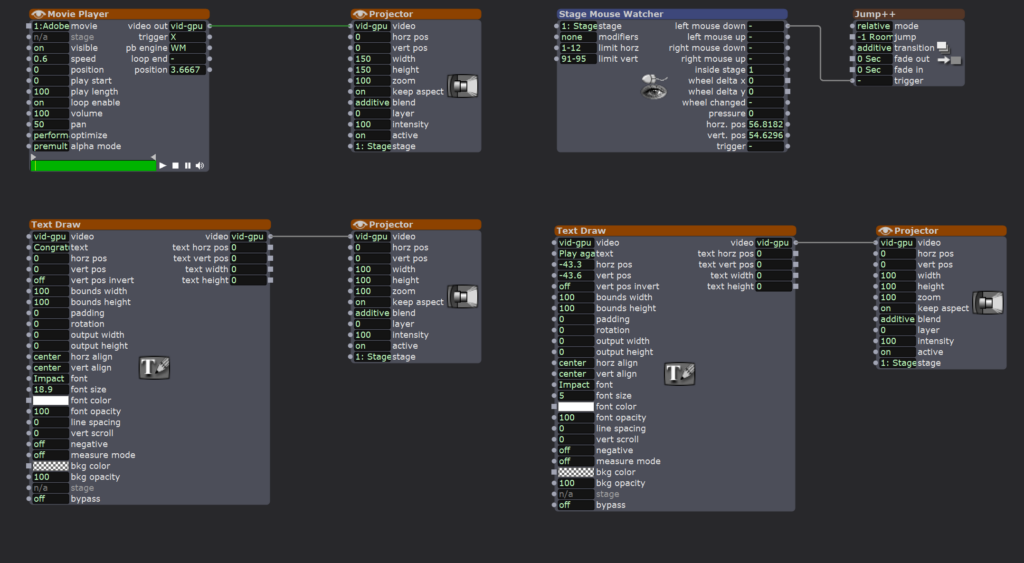
Figure 3: A Cleaner Scene 2
The thing I really ran out of time for, and, I admit, I ran over on time in general, was the controller. I had a better, more designed idea, but the connections between the wires and buttons wasn’t strong enough to be consistent, and I was more interested in a smooth experience at the expense of the look of the controller. To that end, at the presentation, it felt like the controller was easy to use and understand, which pleased me. I didn’t want the mechanics of use to take away from the experience itself, so that was a win. In the things I’m creating, I’m interested in a level of engagement that doesn’t require training or too much figuring out; I want it to be easily playful and, therefore, usable for a wider array of folks.
If I’d had more time, I would have added more items to the room, though the cleanliness of the mess seemed to appeal to the users. I think there’s something to be said for a streamlined interface and screen, especially where play is involved. Users also noted that sound would have enriched the experience, and I definitely agree with that note/wish I’d had time to think of and include that. It’s, admittedly, the last aspect on the priority list, below making my project work, but something I will certainly try to leave time for in the future. This points to a need, in general, for me moving forward, which is to think through all the pieces I need to figure out for a project and make sure to leave at least some time to address them, even if it’s a little frankensteined.
I think there are uses to the things I figured out for this project, especially in relation to gate and triggers. I can see this being very useful as I move into my Cycles and the way I’m thinking about creating an experience and having interactions work in that experience. (Figure 4)
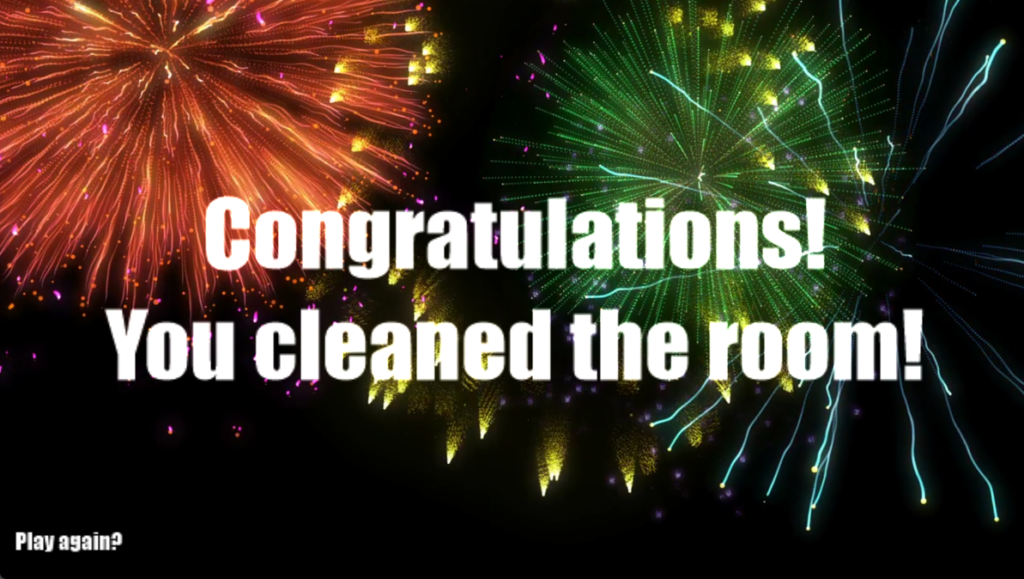
Figure 4: Success!
Figure 5: Video of Final Project
Pressure Project 2: Creating an Escape
Posted: February 25, 2025 Filed under: Uncategorized Leave a comment »For this second pressure project, I had seven hours to design an interactive mystery without using a traditional mouse and keyboard. Based on feedback from my first project—which felt like the start of a game—I decided to fully embrace game mechanics this time. However, I initially struggled with defining the mystery itself. My first thought was to tie it into JumpPoint, a podcast series I wrote about time travel, but I quickly realized that the complexity of that narrative wouldn’t fit within a three-minute experience. Instead, I leaned into ambiguity, letting the interaction itself shape the mystery.
My first hour was spent setting up a live video feed that would give the user questions regarding their current state and environment. To achieve this, I utilized actors such as video noise and motion blur. My initial concept was to have the experience activated via depth sensors, something I had actively avoided in my first project. I set this up, only to realize that to ultize both my high quality web cam as well as the makey makey, all my USB drives were being utilized. So I pivoted to a sound level watcher which would activate the experience.
My second Cue titled “The Scene” serves as my soundbed for the experience. There is an enter scene trigger that gives the appearance of bypassing this in real time, with the 3rd scene utilizing an Activate Scene actor to trigger the music.
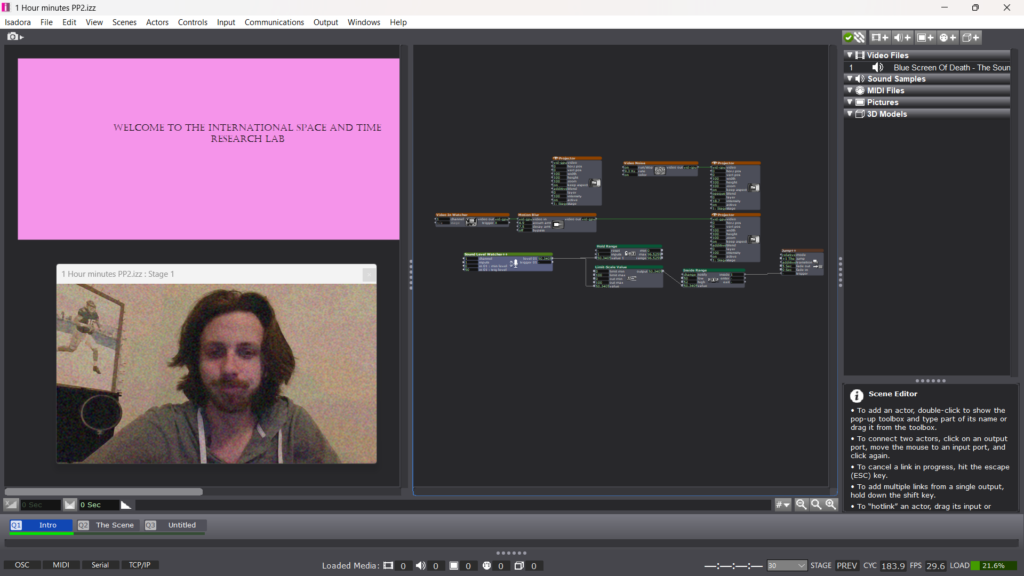
If you view the next screenshot, you will notice that the project says One Hour mark, this is not true. This is also your reminder to save early and save often as twice in this experience, I had the misfortune of having about a half hour of work, each time, disappear.
So between hour one and hour two, I set up what would be the meat of the experience. 3 doors with no clear path behind each. This is where I intended to really incorporate the makey makey as the first cue is activated off of sound. In the control panel, I created 3 sliders and attached them to each shape actor in addition to an inside range actor. What I would achieve by this, is creating the appearance that the door is coming closer if you choose to “open” it, while also creating a number which, when hit, would activate a trigger to a jump ++ actor to take the user to either Door 1, 2, or 3’s outcome. A mouse watcher was also added to track the movement from the Makey Makey, which at this point, I had not decided how it would be arranged.
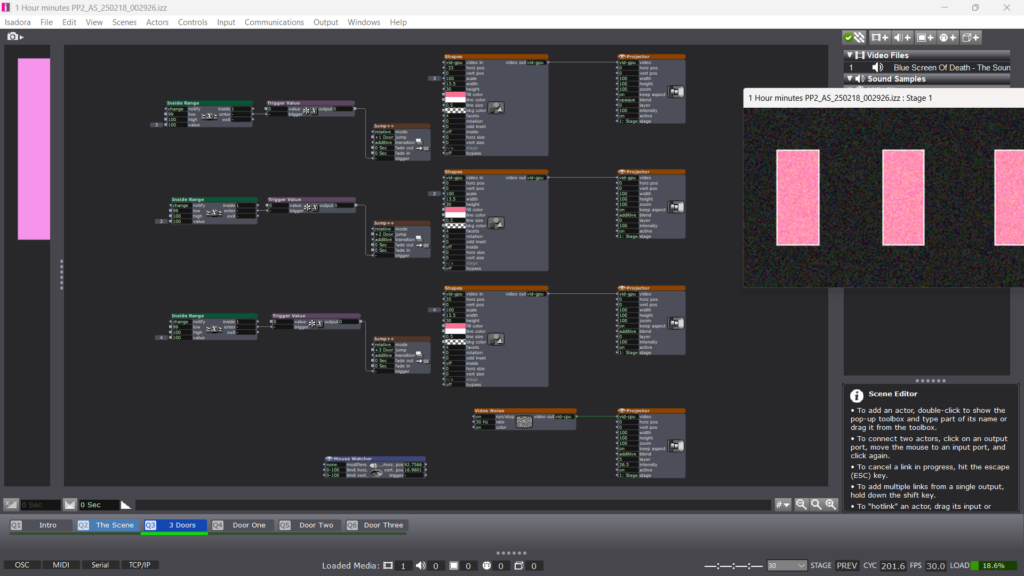
Over the next hour, I would set up the outcomes of doors 1 and 3. Wanting to unlocked the achievement of “expressing delight”, I decided that Door 1 would utilize a enter scene trigger for 3 purposes. 1. To Deactivate the Sound bed. 2. To Activate a video clip to start. The video clip is from Ace Ventura: Pet Detective where Ace, dishelved, comes out of a room and declares “WOO, I would NOT go in there!!”. For the 3rd purpose of the enter scene trigger, I inserted a trigger delay for the duration of the clip to a Jump++ actor to go back to the three doors.
Behind Door 3, I decided to set up a riddle or a next step.To set this up, I utilized a text draw that would rise via an envelope generator. You’ll observe a few other actors, but those were purely for the aesthics. I wanted users to be able to use the Makey Makey in another capacity, so I utilized serval keyboard watchers to hopefully catch every letter being typed. I had made several attempts to figure out how exactly that I needed to inventory each letter being typed before emailing my professor who helped out big time!
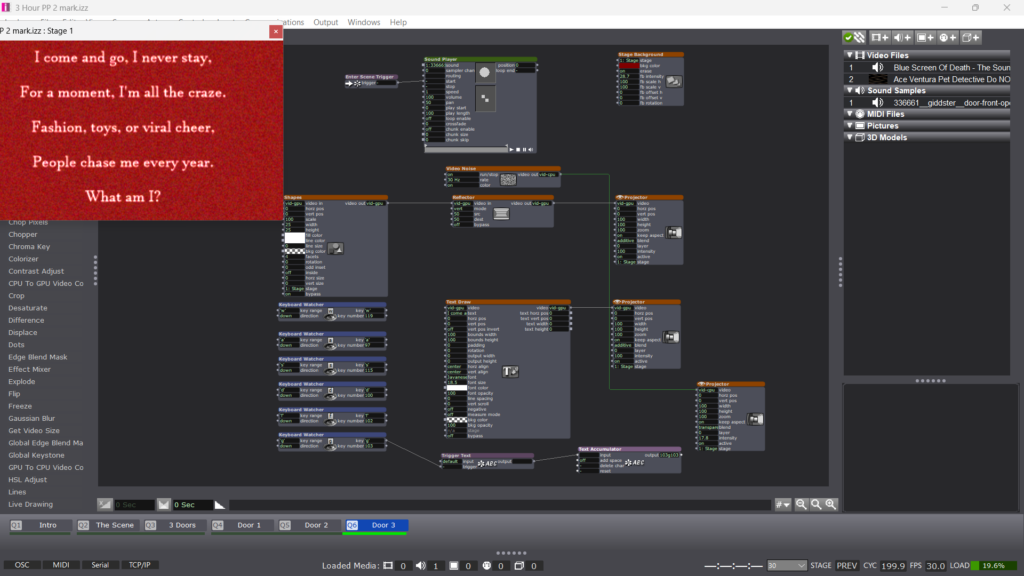
While I awaited a response, I spent about half an hour experimenting with the makey makey testing it’s robustness with and without playdough, which I intended to be the conduit for the experience. Please ignore the messy desk, a mad scientist was at work.
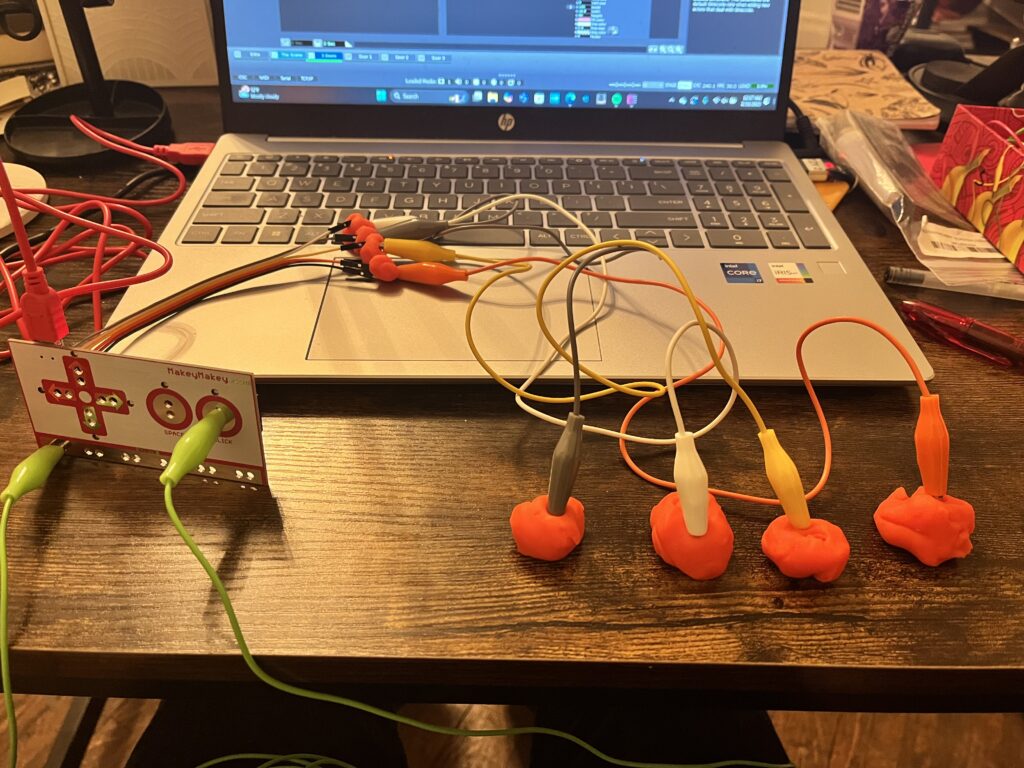
Hour 5 is where my pressure project went from being a stressor to being REALLY fun. (Thanks Alex!) Instead of a keyboard watcher, I created 6 text actors to coordinate with WASDFG. Those text actors would connect to a text accumulator which was attached to 2 additional actors. A text draw, which would put it on screen as I intended and a text comparator, which, when it matched the intended answer, would take send a trigger to take the actor to another scene. Instead of using the WASDFG inputs of the makey makey, I stuck to the directional and click inputs that I played around with earlier and instead created those keys with buttons on the control panel. This would still give the user the experience of typing their answer without having to add 6 additional tangible controls. As hour five drew to a close, I set up the outcome of door two which mirrors features and actors of the other two doors.
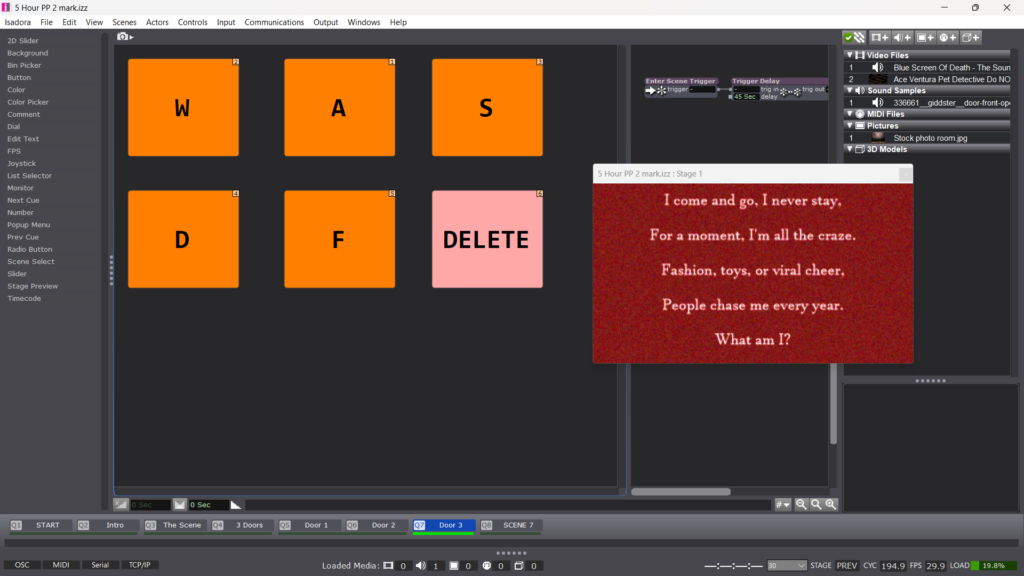
With the high use of the text draw actor, I was unintentionally creating a narrative voice for the piece. So in the 6th hour I worked on the bookend scenes to make it more cohesive. I added a scene at the top which included a riddle to tell the user the controls. I also used an explode actor on the text to hopefully instill the notion that the user needed to be quiet in order to play the game (which they would have to do the opposite on the live video, a fun trick). I created a scene on the backend where I felt that a birthday cake was an interesting twist that didn’t get too dark in plot. I liked the idea of another choice, so I simply decided to narrow down from 3 options like the doors, to 2. Still utilizing buttons in the control panel.
It was also in this sixth hour that I realized I didn’t know how this mystery was going to end. I had to spend a bit of time brainstorming, but ultimately felt that this experience was an escape of some kind, but to avoid going a dark direction, I decided that the final scene would lead to an escape room building.
My final hour was spent on 2 things. 1, establishing the scenes that would lead to the escape room end and setting up the experience in my office and asking a peer to play it so I could gauge the level of accessibility. Feeling confident after this experience, I brought my PP to class where I received positive feedback.
Much like an escape room, there was collaboration in both the tangible experience of controlling the escape room as well as decision making. I did observe that the ability to discern which parts of the control were the ground and the click wasn’t clear. In the future, I would like to distinguish these a bit more through an additional label.
Something else that occurred was the live video scene instantly bypassed due to the baseline level of volume in the room. So in the future, I would utilize the actor to update the range in real time as opposed to the hold range actor that I used as a baseline.
With how much jumping was occurring through scenes, I struggled throughout with ensuring the values would be were I wanted them upon entry of each scene. It wasn’t until afterwards that I was made aware of the initialized value feature on every actor. This would be a fundamental component if I were to work on this project moving forward.
Pressure Project 1
Posted: February 13, 2025 Filed under: Uncategorized Leave a comment »For pressure project one I was inspired by the original Isadora template to keep things simple and looping indefinitely as opposed to creative a narrative. My original instinct was to animate the patch with random positions and shape patterns to create something that was consistently changing to keep the viewer’s attention. Thankfully, Isadora’s license was not valid on my first attempt so I was unable to save my work. On my second attempt, I challenged myself to be a bit more intentional about my choices and work within the scope of the assignment. Knowing that we had the option to use a camera input as a sensor, I began the process of adding some video feedback and interaction to the patch.
Adding the video to the squares was easy enough. From my previous experience with Isadora, I already knew how to add a new user input to the user actors, so it was a simple process. However, I quickly realized that the incoming aspect ratio was rectangular and the shapes we were given were square. In the spirit of simplicity and symmetry, I choose to crop the video to a square. This led to the image having a border and combining the projectors gave the effect of a color filter which I thought was a bit retro and fun. This basic foundation gave me the inspiration for the rest of the patch.
The square image with a thick border remined me of a photo booth and I was off to create an experience that could capture that magic into an interactive experience. I wanted to essentially “take a snap shot” at the same time as the colored square appeared. I found the freeze actor worked perfectly for this. Adding the same trigger as the projector activation synced everything up nicely.
I wanted to refine the images a bit more by changing the way they appeared and disappeared. For this, I wanted to create the effect of turning over a card or picture to reveal what is underneath. I have never tried this in Isadora before so I experimented a bit before I found the 3D projector. The setting on this actor are quite different from the normal projector, but I was quickly able to figure out what most of the options did. To rotate the image, I added a ramp to the Y rotation so it would flip into place when the projector became active. This worked as you might expect, but I did discover there were some artifacts and lines that would tear into the image as the effect was taking place. I played around with the blend modes and layer heights, but nothing seemed to work. Finally I found the “depth test” setting that made the transition smooth and looked good. I would have liked to flip the image back over when it disappeared, but I ran out of time and figuring out the timing and trigger delays was not as important to me as getting a good image.
One of the goals for me on this project was also to explore new actors and refine my methods of using them. I have used the eyes++ actor many times, but with limited success. Recently I have tried filtering the input with a chroma key to isolate faces which has worked fairly well. This technique worked well for trying to essentially “zoom in” on the users face when taking the “photo”. I had to guess what actors to use to do the cropping and centering of the image on the “Blob” but I was able to get something that worked reasonably well.
When it was time to present, I quickly realized the camera tuning I had done in my office at home was producing the same results in the classroom. I was able to franticly changes some setting to get it working again just before our presentations began. For the presentation itself, I choose to display the stage on the classroom TV. This was similar to how I had programmed everything in my office with second display. I was excited to see how others would react and I was pleased that most people seemed to enjoy the experience. One thing I did notice was that at some point people started to back away from the screen. This was partially to give others space, but I think it was also because the camera was essentially following them and they didn’t want their picture taken. For a future iteration I might try to limit the range of the camera so it only interacted with people at a certain range and distance.
Overall, I enjoyed working on this project and I’m happy I was able to keep most of the original programming intact.



Pressure Project 1: Building a Galaxy
Posted: February 4, 2025 Filed under: Uncategorized Leave a comment »Deviating from the original self-generating patch to create something unrecognizable was a process of playing with the shape and wave actors tucked inside of each 50-50 box. Although my patch made several leaps from the original source, this was ultimately an exercise in the unpredictability of not only pattern but challenge. The process of experimenting, problem-solving, and making creative choices based on trial and error allowed me to develop something unique. Each step in the project introduced new discoveries, frustrations, and moments of inspiration that shaped the final product.
I worked on this project in intervals that felt manageable for me. Whenever I could pop the thumb drive in, as long as I wasn’t becoming frustrated, I could keep trucking forward. The moment I’d hit a wall was when I found value in stepping away and coming back with a fresh perspective. Allowing myself space to breathe through the creative process kept me from overworking certain ideas or becoming too attached to one solution. I created drafts at the following intervals: 1 hour, 1.5 hours, 3.25 hours, 4.5 hours, and 5 hours. Each session built upon the last, adding layers of depth and refinement to the patch.
My first hour consisted largely of two things: playing around with different shapes and patterns that were visually appealing to me and organizing the 50-50 boxes onto virtual stages to ensure I was adjusting the correct parameters on the patches. This initial exploration allowed me to get comfortable with the software and begin to establish an aesthetic direction. I decided to take the second 50-50 box and duplicate these hexagon shapes, as evident in the video. I considered having a blinking hexagon of another color travel through the lines of hexagons to give the illusion of movement. Initially, I intended to duplicate this pattern across the whole screen, but as the hour passed, I realized this approach would be too meticulous for what I was looking to accomplish in the given timeframe.
For the first 50-50 box, I experimented with some video actors. I inserted the explode actor between the shape and projector while also adding a wave generator to the vertical position, giving the illusion of a bouncing ball. This small animation gave me my first taste of how dynamic movement could be implemented within the patch. The interplay between controlled movement and randomization became an interesting area to explore.
The next 30 minutes would get interesting as the black void of the stage became strikingly apparent to me. I wanted to texture the space a bit to avoid a completely flat background. I found a background color actor that fixed this problem, but I didn’t like how flat it felt. To enhance the visual complexity, I used the explode actor to create a grain-like texture behind my shape actors. Additionally, I decided to see if I had any audio on my computer to throw in for inspiration. I landed on an ’80s-style synth instrumental. The combination of this music with the textured background inspired me to create an outer-space-style scene. Wanting to reinforce this theme, I focused on making shapes appear to be floating or traveling. I took my bouncing ball from before and added a wave generator to the horizontal parameters, which gave the illusion of flight. However, at this point, I noticed that the projector crop was cutting off the shape along the horizontal base, creating an unexpected limitation that I would need to address later.
In the fourth 50-50 box, which I renamed Box 4, I added a wave generator and a limit scale value actor to the facet’s parameter of the shape. I decided to limit these values between 3 to 6 to keep the shape sharp and prevent it from becoming too rounded. Additionally, I thought it would be fun to implement the same actors to the projector zoom, but this time keeping the values between 100 and 400. This gave the illusion that the shapes were not only increasing in facets but also in size. The unexpected interplay of these parameters created a more organic transformation, making the visuals feel dynamic rather than rigid.
Over the next hour and 45 minutes, I focused on giving my stage actors and parameters that made the piece feel not only like space but something alive. I experimented with my background color and explode actors to create movement when I discovered an actor called Video Noise that resolved this issue beautifully. I also added a subtle stage background actor to adjust the color beneath the noise.
Additionally, as I became more comfortable utilizing Inside Range actors, I decided to base some sort of cue off the music. I connected an Inside Range actor to the position parameter of the movie player, which tracked the number of seconds in the song. Unsure if I could maintain attention for more than 30 seconds, I aimed for something around the 20-second mark. I set my low at 20 and my high at 21, which would then trigger a wave generator. I connected the sawtooth wave generator to two limit scale value actors—one to set the scale position and another to set the vertical position of a shape actor that I envisioned as a planet. I originally attempted to create something that resembled Saturn with a ring around it, but eventually, I realized I was spending too much time refining this one parameter. I ultimately settled on creating dimension via a line size.
Over the next hour and fifteen minutes, I primarily focused on two elements. First, I organized my patch as it was now becoming necessary due to its increasing complexity. Second, I worked on establishing a “night sky” transition. I copied the base 50-50 box and tried to create an explosion that would become the primary layer. Initially, I tried to trigger this effect four seconds after the initial planet would rise, but that didn’t work. I then tried adding an Enter Scene trigger with a trigger delay set for about 24 seconds. This was when I realized the hurdles of real-time rendering, so I created a second scene, which was blank, to flip back and forth between and determine whether my actors were behaving as intended
My final 30 minutes focused on going back to basics and trusting what was working. I scrapped my night sky idea but repurposed the box to return to the galaxy tear concept. I took the night sky and created a shape that resembled the planet. I then used the explode actor and a random wave generator to trigger varying horizontal ranges, creating the illusion of a dying planet.
At this point, the rapid shape actor I had developed in the first hour and a half was feeling stale. To add texture, I introduced the dots actor. However, I wanted to maintain an unpredictable pattern, so I connected the established Inside Range actor to a toggle actor that would turn the dots actor on and off whenever the range from the random wave generator fell between 50 and 100. This was one of my proudest moments, as it allowed me to create something far from the original patch.
At this point, my work was done. I was proud of myself for creating a fun visual that accomplished my goal of creating an outer-space-like scene. This project was a great exercise in evaluation—identifying which actors and elements were useful and which needed to be discarded. Some core ideas were thrown out only to return in new forms, such as the galaxy tear transforming into a dying planet.
During my presentation, I was nervous about whether the piece would hold interest for more than 30 seconds. However, my peers provided valuable feedback. Due to the planet shifting around 20 seconds in, they expected more to happen. This small movement not only shifted expectations but also broke the pattern completely. Additionally, they mentioned that the project felt like the start screen of a video game, meaning my music choice and visuals were in harmony. In the future, I would tackle one box at a time rather than jumping around, which would improve organization and efficiency.
Pressure Project 1
Posted: February 4, 2025 Filed under: Uncategorized Leave a comment »For Pressure Project 1, my key strategy was to find a story and see if I could successfully shape abstract visuals to convey that story, or some semblance of a story line with a clear beginning, middle, and end (Figure 1). I recognize that I struggle to make art that doesn’t tell a story (and struggle even more, perhaps, to make up that story myself, being an artist who makes art that expresses stories created by other people), so initial attempts to create something visually interesting without a central framework around which to form it did not go very far for me. I was able to start to brainstorm ways I might alter the initial patch to at least create visual interest and then used those initial alterations to build other iterations. I ended up working from the center of my scenes outward, alternating working toward the beginning and then toward the end without a clear plan but rather as ideas came to me or I thought of ways to advance the visual story. Working in first one direction and then the other gave me something to work toward (I won’t say goal!) and allowed me to explore how to get from point B to points A and C respectively. I wanted to challenge myself to explore actors I hadn’t had a real opportunity to implement before, as well as try to get a stronger handle on how the ones in the initial patch were functioning. I think I only minorly succeeded in this endeavor, but I did feel that, overall, I was able to gain some amount of facility with the tools I was using.
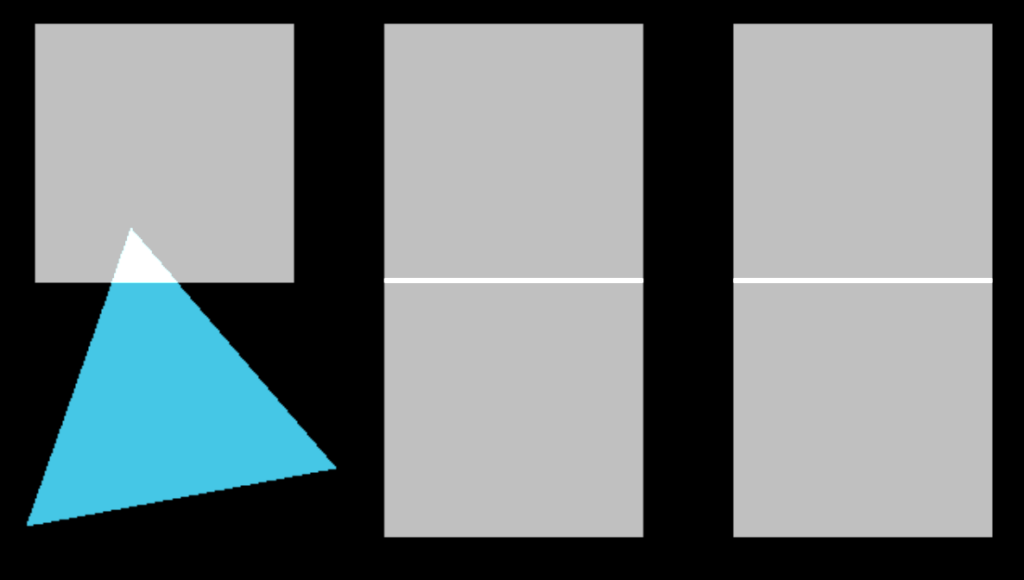
Figure 1
I played a lot with the Wave Generators (Figure 2) and the User Actors, mostly trying to get a better handle on the latter. At one point, this somewhat inadvertently led to me recreating the initial patch from scratch with some alterations, but I’m chalking that up to valuable time spent playing and learning (Figures 3 and 4). I also tried out the Movie Player actor and started messing around with the Play Start and Play Length fields. I also dipped my toe into the effects, like Explode, and know that I have a lot more exploring to do there.
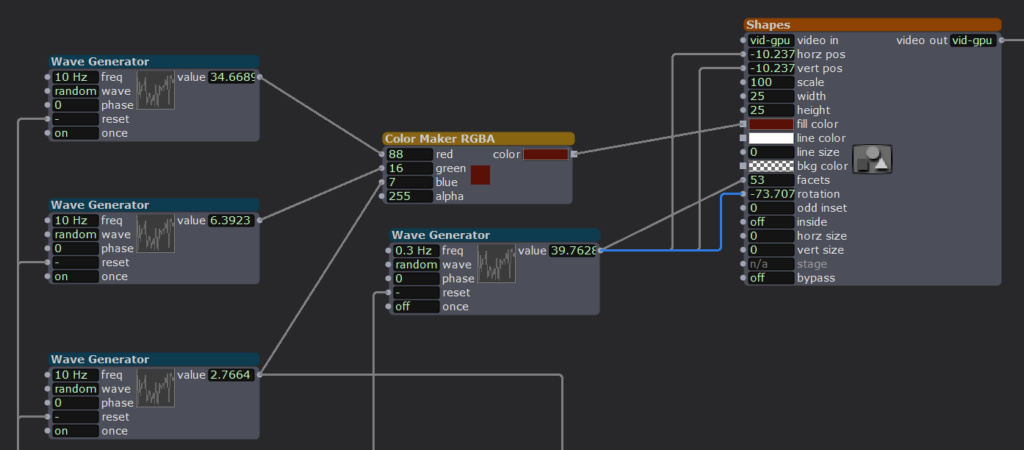
Figure 2
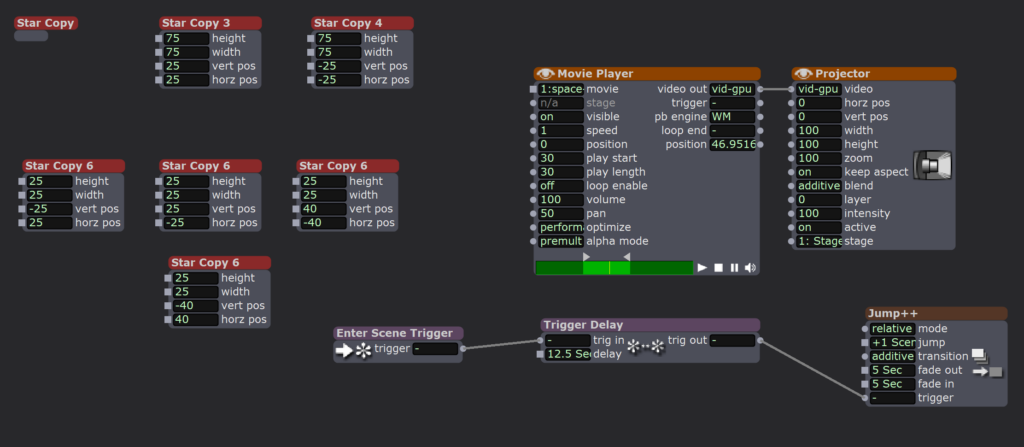
Figure 3
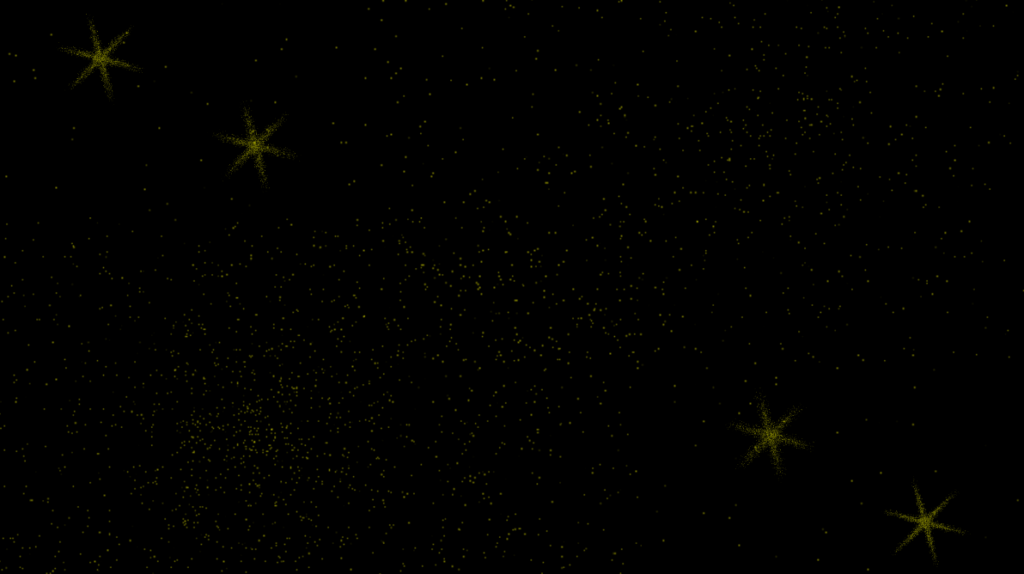
Figure 4
The main challenge for me, I think, is just that I am very much a novice with this type of work and, as I said before, struggle to design if I don’t have a clear framework (i.e. a story) around which to base my work. I’m struggling, in general, to put the pieces together and remember how things work, but spending my time breaking and repairing some of the things in the initial patch helped with that a bit. This speaks less to this project in particular and more to a large issue, but it also took me a decent amount of time to find assets such as music and video to use, once I decided to use them, and I had to settle for watermarked material, which was fine if not a little annoying (Figure 5). Related to all this, at some point I had to just decide to use this as practice and try to play to my beginner-level strengths; my challenge here and moving forward will be to be satisfied with where I am, skills-wise, and to find ways to create things with those limited resources, for now, growing the resources as I can but also knowing that it’s ok to create within what you have.
While my project went a wildly different direction than those of my classmates, I think it was relatively well-received. Where after staring at it over and over again I had become concerned with the pacing, based on feedback, it seemed like, while it was a little slow, the pace ultimately supported the arc of the project if you didn’t know how it was going to play out. That was my aim, but it had become hard to discern whether or not that was being achieved after watching it over and over again for the last hour or so of my time spent on the project. I appreciate, too, that I have a ways to go in terms of presentation and how to do it in a way that looks more finished; I had no idea that you could make the window bigger and block out the scenes! Additionally, while I did finally figure out how to make a video of my presentation (below), I cannot figure out how to also make it have sound. I assume there is a way, but maybe there isn’t… something to explore, I suppose!
All-in-all, I was pleased with how my project turned out. I think I set attainable aims for myself and achieved those, so I’m also quite pleased with myself for being able to realistically assess my abilities/resources. I think that will serve me quite well as we continue through the semester.
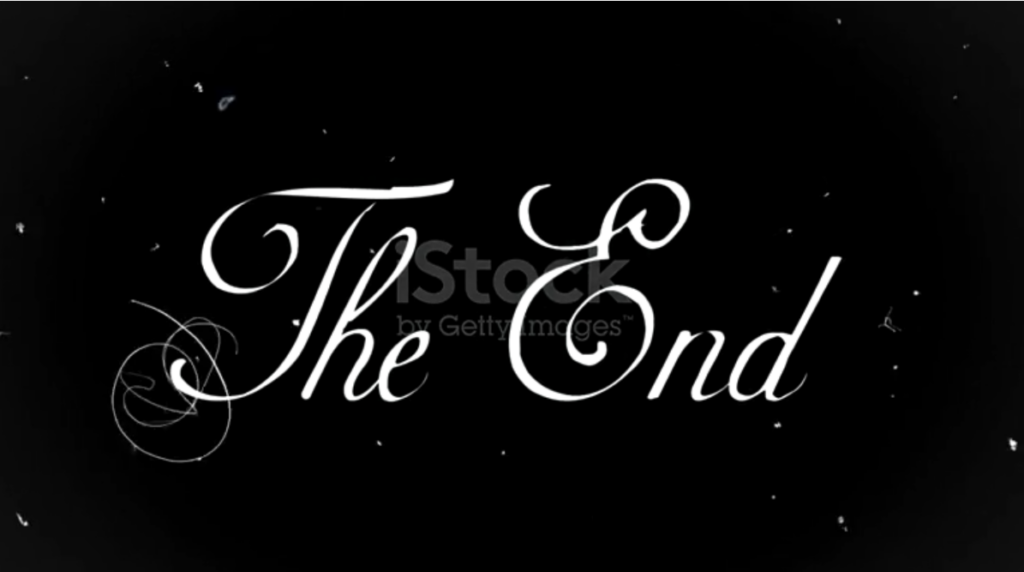
Figure 5